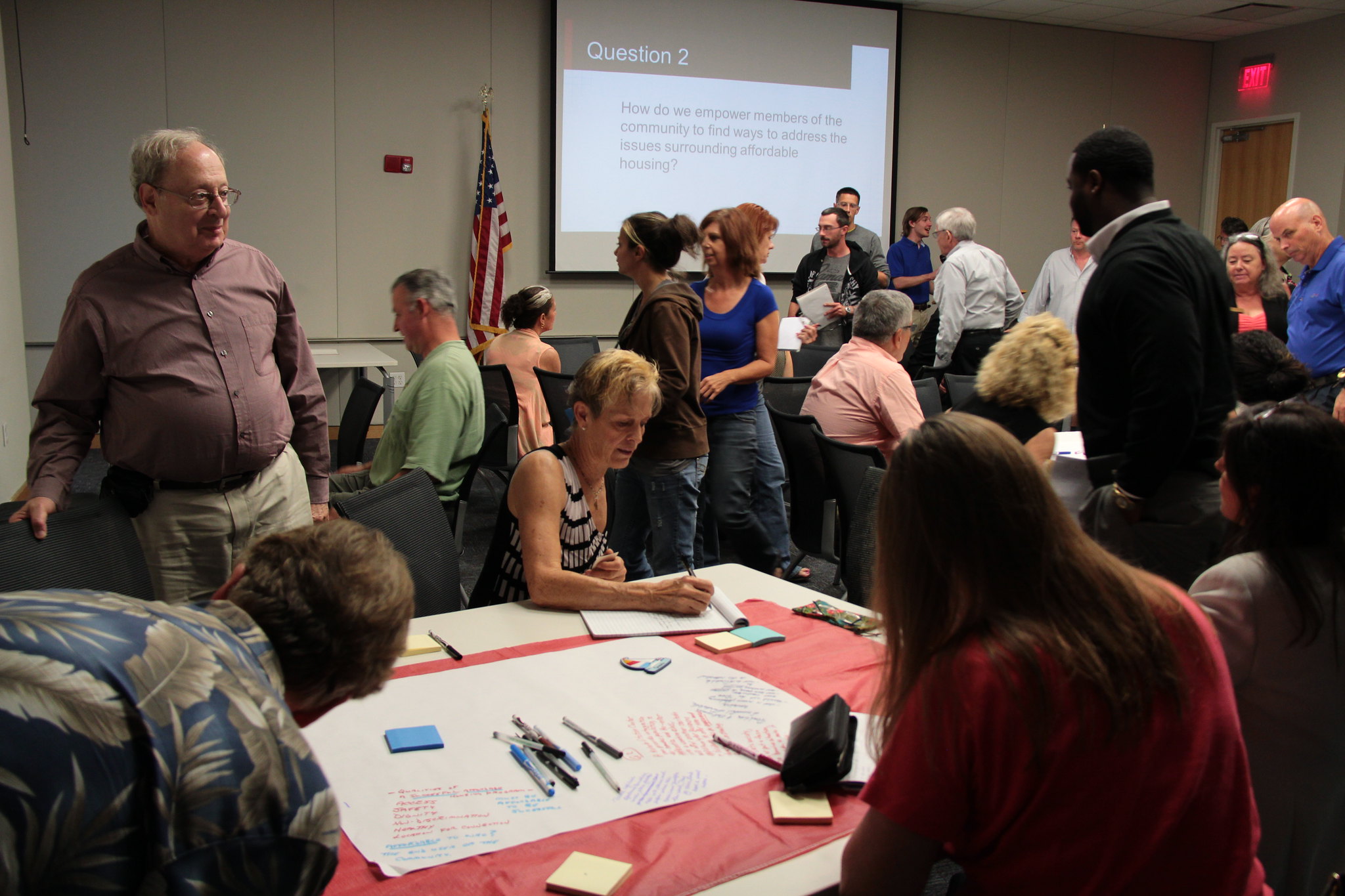
With more than a thousand homeless people counted on a given night in Sarasota, the community has rallied around a few buzzwords. “Enablement,” “come as you are” and “93 percent” are on the lips of everyone arguing for and against the various solutions for Sarasota’s street-sleepers. But a new phrase has emerged and seems to have civil servants and case managers excited: “housing first.”
At a public meeting last Wednesday conducted by Professor of Sociology David Brain and Sarasota Area Commander of the Salvation Army Major Ethan Frizzell, a group of students in Brain’s Practicum in Community Building tutorial presented an analysis of national and local trends in affordable housing. After a brief presentation, attendees were welcomed to the “World Cafe” format of discussion, which requires guests of each table to travel to another group when a new question is asked.
“The questions presented by the students for the ‘World Cafe’ conversation raised more questions than they answered,” Jaclyn Tredway of Bay to Bay Services said. “The discussion of how quality of life would be apparent as an outcome of successful affordable housing, was agonizing.” Tredway has attended each one of the monthly community meetings. She was formerly homeless and now lives in a tiny house. Despite her positive experience with a tiny house, Tredway advocates for a “fallout shelter” which would consist of “little more than a structure that provides protection from weather, [provides] snacks and water […] to accommodate many souls on few mattresses.”
While Robert Marbut condemned Sarasota from enabling the homeless by giving money to panhandlers – citing that 93 percent of that money is spent on drugs and prostitution – he also suggested that a “come as you are” shelter would be the solution to the city’s woes. After the shelter plans were halted by a City Commission vote, homelessness advocates and lawmakers had to find a new solution.
The discussion at the public meeting spotlighted a few options that have cropped up around the country to alleviate housing crises. Tiny houses – homes which are sustainable, livable, minimal and yes, tiny – are a popular option with artistic communities like Sarasota. Neighborhoods of tiny homes such as Dignity Village in Portland, Ore. have proven to be successful in fostering community values in formerly homeless individuals. Subsidized public housing is another option. Currently, the Sarasota Housing Authority (SHA) offers subsidized rent to individuals whose income is less than 80 percent of the median area income – which, in Sarasota, is $57,300 as of 2014. SHA currently operates 407 units of public housing and is in the process of adding more. However, the Sarasota City Housing Support Document cites that there is a need for more than 2,000 new units over the next 10 years in order to accommodate low incomes.
According to the United States Interagency Council on Homelessness (USICH) Housing First is an approach which focuses on obtaining affordable housing as quickly as possible for homeless individuals, and then supplying case management and other services. In other words, the primary goal is placing people into housing, everything else – from rehabilitative services to child care – comes next.
“I would rather be a part of a proactive consultation on the implementation of ‘Humane Housing’ and provision of ‘Homes First’ rather than ‘Housing (Houses) First,’ which can have unintended side effects of the giving of ‘too much, too soon,’ and aiming too low in goals and potential,” Tredway said. “Humane housing begins with meeting the most fundamental needs of all: safety, security, sense of well-being and a loving environment. The last comes from the unconditional love of the extended family of community, and forms the foundation for receptivity to the sequential education of the spirit that mines and refines the gems of self-discovery in talents, purpose and potential.”
Housing First emerged out of the idea that many people who have become homeless for purely economic reasons are not well served by homeless shelters and other social services. For many, the only thing that is missing is affordable rent which does not provide a cost burden to the family.
A cost-burden is defined by the United States Department of Housing and Urban Development (HUD) as a rent which exceeds 30 percent of a person’s monthly income. As of the most recent report by the City of Sarasota in 2008, 42 percent of renters are paying more than 30 percent of their income for rent.
Housing First depends on the availability, diversity and affordability of housing in an affected area. Although public meetings initiated by New College and the Salvation Army have begun an unprecedented dialogue on homelessness and housing needs in Sarasota, their goal was not to create or suggest policy. “I would like to join other activists, non-profits, students, business owners, elected civic leaders, residents of directly affected neighborhoods and stakeholders to begin community engagement and consultation gatherings, similar to the ones initiated by the Salvation Army,” Tredway said. “Being a consultation as opposed to a dialogue, they would be looking more to proactive solutions than discussing problems. They would be very ‘just do it’ oriented.”
Information for this article was taken from usich.gov, scgov.net, huduser.org.
